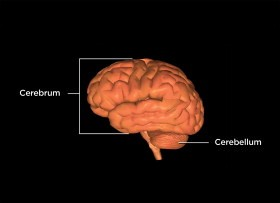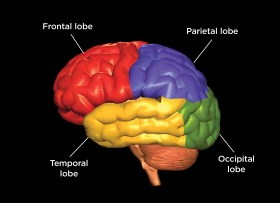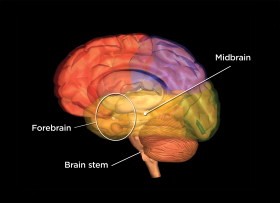The Cerebral Hemispheres
The Cerebellum
 The cerebellum is a cauliflower-shaped structure, located just above the brain stem. The cerebellum regulates muscle tone, coordinates movement and helps maintain posture and balance. It does not initiate movements, but is responsible for their smooth and balanced execution, for maintaining muscle tension and making movements work together in complex activities such as walking.
The cerebellum is a cauliflower-shaped structure, located just above the brain stem. The cerebellum regulates muscle tone, coordinates movement and helps maintain posture and balance. It does not initiate movements, but is responsible for their smooth and balanced execution, for maintaining muscle tension and making movements work together in complex activities such as walking.
It comprises approximately 10 percent of the brain’s volume, contains at least half its neurons and is connected to the brain stem via three major bundles of input and output fibers called peduncles.
The Cerebrum
The cerebrum, a large rounded structure, is closely related to functions including thought, reason, emotion, and memory. It occupies most of the cranial cavity and is divided into two hemispheres that are joined at the bottom by the corpus callosum. The two hemispheres are mirror images of each other and control opposite sides of the body. The left cerebral hemisphere controls speech and academic and analytical processes; the right hemisphere deals with artistic and imaginative activities, and also controls facial perception and music.
The Lobes
 Each cerebral hemisphere is subdivided into four lobes: occipital, temporal, frontal and parietal.
Each cerebral hemisphere is subdivided into four lobes: occipital, temporal, frontal and parietal.
- The occipital lobes are pyramid-shaped structures located at the back of the brain that receives and analyze visual information.
- The temporal lobes, located on the skull side of each hemisphere (near the ears), deal with hearing.
- The frontal lobes, at the front of each hemisphere behind the forehead, are responsible for cognitive thought processes (knowing, thinking, learning and judging). They also regulate voluntary movements.
- The prefrontal areas of these lobes are involved with intelligence and personality.
- The parietal lobes, located above the occipital lobes, are mainly associated with our sense of touch and balance and are important in interpreting sensory information from various parts of the body, and in the manipulation of objects.
Both cerebral hemispheres are covered by the cerebral cortex, which has many folds and resembles a walnut kernel. The gray outer layer of the cerebral cortex contains neurons and dendrites — branched projections that conduct electrical stimulation to the cell body. This outer layer surrounds a thicker layer of white matter made up of nerve fibers.
 The brain stem contains the midbrain, pons and medulla oblongata. The midbrain — the uppermost part — has fibers that connect the brain stem to the cerebrum and cerebellum; this area is very important in the control of skeletal movements. The pons, which lies between the midbrain and medulla oblongata, relays sensory information between the cerebrum and cerebellum. The medulla oblongata contains centers for the control of breathing and cardiovascular function.
The brain stem contains the midbrain, pons and medulla oblongata. The midbrain — the uppermost part — has fibers that connect the brain stem to the cerebrum and cerebellum; this area is very important in the control of skeletal movements. The pons, which lies between the midbrain and medulla oblongata, relays sensory information between the cerebrum and cerebellum. The medulla oblongata contains centers for the control of breathing and cardiovascular function.




